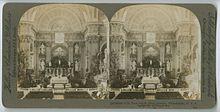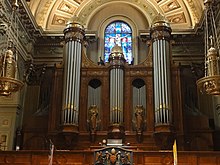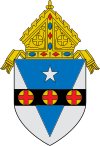United States historic place
| Cathedral of Saints Peter and Paul | |
| U.S. National Register of Historic Places | |
 The Cathedral Basilica of Saints Peter and Paul in Philadelphia The Cathedral Basilica of Saints Peter and Paul in Philadelphia | |
   | |
| Location | 18th St. and Benjamin Franklin Parkway at Logan Square Philadelphia, Pennsylvania |
|---|---|
| Coordinates | 39°57′27″N 75°10′7″W / 39.95750°N 75.16861°W / 39.95750; -75.16861 |
| Built | 1846–1864 |
| Architect | Napoleon LeBrun, et al. John Notman, et al. (dome and facade) Constantino Brumidi (murals) |
| Architectural style | Italian Renaissance, Palladian |
| NRHP reference No. | 71000720 |
| Added to NRHP | June 24, 1971 |
The Cathedral Basilica of Saints Peter and Paul, head church of the Roman Catholic Archdiocese of Philadelphia, stands on 18th Street on the east side of Logan Square, at the Benjamin Franklin Parkway. It was designed by Napoleon LeBrun to plans by the Reverend Mariano Muller and the Reverend John Tornatore and built between 1846 and 1864. Its dome and Palladian facade, by John Notman, were added after 1850. The interior was decorated by Constantino Brumidi.
The largest Catholic church in Pennsylvania, the cathedral was listed on the U.S. National Register of Historic Places in 1971. It has been the site of two Papal Masses, one celebrated by John Paul II in 1979, the other by Francis in 2015. The current rector is the Reverend Gerald Dennis Gill; the current archbishop of Philadelphia is Nelson J. Perez.
History
On the Feast of Saints Peter and Paul, June 29, 1846, Bishop Kenrick, then Bishop of Philadelphia, issued a pastoral letter announcing his determination to build a cathedral.
Philadelphia had two cathedrals before Saints Peter and Paul. The first Catholic church in Philadelphia was Saint Joseph's, which was built in 1733. As the Catholic Church grew, a new church called Saint Mary's was built in 1763; it became Philadelphia's first cathedral in 1810. As the Catholic Church continued to grow, Saint John the Evangelist was made the cathedral in 1838 when a larger church was needed. Saint John's remained the cathedral until Bishop Kenrick began work on the Cathedral Basilica of Saints Peter and Paul.
The sale of burial lots at Cathedral Cemetery and New Cathedral Cemetery were used to help fund the building of the Basilica.
It was the bishop's intention to avoid running into debt, so the cathedral was long in building. He chose for the site a plot of ground adjoining the seminary at Eighteenth and Race Streets. Construction on the cathedral began shortly after the bishop's pastoral letter in 1846 but was not completed until 1864. The construction began less than 2 years after the Philadelphia Nativist Riots of 1844, which represented the height of Anti-Catholicism and Know-Nothingism in Philadelphia and, according to local lore, greatly influenced the design of the building. The cathedral was built with only very high clerestory windows that according to parish histories would inhibit vandalism. In order to protect the windows of the Cathedral Basilica from possible future riots, the builders would throw stones into the air to determine the height of where the windows would be placed.
In 2017, the shrine of Saint Katharine Drexel was relocated to the cathedral after its former home, St. Elizabeth's Convent, was closed and sold off by the Sisters of the Blessed Sacrament.
Building



With its grand façade, vaulted dome, ornate main altar, eight side chapels and main sanctuary that comfortably holds 2,000 worshippers, the Cathedral Basilica of Saints Peter and Paul is the largest brownstone structure and one of the most architecturally notable structures in the city of Philadelphia.
The cathedral, presented in a Roman-Corinthian style of architecture, is modeled after the Lombard Church of St. Charles (San Carlo al Corso) in Rome. Its Palladian façade and aqua oxidized-copper dome are in the Italian Renaissance manner, as is the spacious interior, which features an oversized apse of stained glass and red antique marble in proportions reminiscent of Roman churches. A baldachin (canopy) over the main altar and the three altars on each of the side aisles point up this Italian Renaissance flavor. In the bowels of the building is the compact "Crypt of the Bishops".
Architects and designers
The basilica was designed by Napoleon LeBrun based on plans drawn up by the Reverend Mariano Muller and the Reverend John B. Tornatore, and by John Notman who added the dome and facade. LeBrun supervised the project from 1846 to 1851, when Notman took over until 1857, after which the cathedral was completed under LeBrun's supervision.
LeBrun was a native Philadelphian born to French-Catholic parents. He designed numerous churches throughout Philadelphia, including St. Patrick's Catholic Church, Twentieth Street in 1841; the Seventh Presbyterian Church in 1842; the Scot's Presbyterian Church in 1843; the Catholic Church of St. Peter the Apostle (German), Fifth Street in 1843; and the Protestant Episcopal Church of the Holy Nativity in 1844, which ios no longer standing. Other notable buildings he designed include the Philadelphia Academy of Music on South Broad Street.
Notman is noted for his Philadelphia ecclesiastical architecture for the Protestant Episcopal Church, including St. Mark's Church on Locust Street in 1850; St. Clement's Church on 20th Street in 1857; and the Church of the Holy Trinity on Rittenhouse Square. He also designed the Athenaeum of Philadelphia and parts of the New Jersey State House.
Constantino Brumidi painted the ceiling mural in the dome, The Assumption of the Virgin into Heaven in 1868, and the round portraits of St. Matthew, St. Mark, St. Luke, and St. John on its pendentives. Brumidi was a Greek/Italian-American painter, known for his murals in the United States Capitol in Washington, D.C., including The Apotheosis of Washington in the dome of the rotunda.
Architect Henry D. Dagit renovated the cathedral interior, 1914–1915, adding the apse behind the High Altar. D'Ascenzo Studios executed the apse's stained glass windows and mosaic murals.
In 1915, four bronze statues of Mary, mother of Jesus, Jesus, Saint Peter, and Saint Paul were added in niches on the building's main facade.
Ordinaries of Philadelphia


Under the main altar of the cathedral is a crypt with the remains of most of the bishops and archbishops, and of several other clergymen, of Philadelphia. The crypt can be reached by stairs behind the main altar. The crypt is the final resting place of:
- Michael Francis Egan, O.S.F., first bishop of Philadelphia, consecrated October 28, 1810, died 1814
- Henry Conwell, second bishop of Philadelphia, consecrated 1820, died April 22, 1842
- James Frederick Wood, fifth bishop and first archbishop of Philadelphia, died June 20, 1882
- Patrick John Ryan, sixth bishop and second archbishop of Philadelphia, died February 3, 1911
- Edmond Prendergast, seventh bishop and third archbishop of Philadelphia, died February 26, 1918
- Dennis Joseph Dougherty, eighth bishop, fourth archbishop of Philadelphia, and first to be elevated to cardinal, died May 31, 1951
- John Krol, tenth bishop, sixth archbishop of Philadelphia, and third to be elevated to cardinal, died March 3, 1996
- Anthony Joseph Bevilacqua, eleventh bishop, seventh archbishop of Philadelphia, and fourth to be elevated to cardinal, died January 31, 2012
Other entombments
- Katharine Drexel, Catholic Saint, Sisters of the Blessed Sacrament Founder, 1858–1955 (buried at St. Elizabeth's Convent and relocated to the cathedral in 2017)
- Francis Patrick O'Neill, pastor of St. James, Philadelphia, 1843–1882, died 1882
- Maurice Walsh, pastor of St. Paul's Philadelphia, 1832–1888, died 1888
- James Corcoran, professor at Saint Charles Seminary, died 1889
- James J. Carroll, bishop, died 1913
- Francis J. Clark, bishop, died 1918
- Cletus Joseph Benjamin, bishop, died May 15, 1961
- Gerald P. O'Hara, bishop, died July 16, 1963
- Francis Brennan, Prefect of the Sacred Congregation for the Discipline of the Sacraments, the first American to receive an appointment to the Roman Curia, died July 2, 1968
- Gerald Vincent McDevitt, bishop, died September 29, 1980
- John Patrick Foley, president of the Pontifical Council for Social Communications, seventh Philadelphia priest to be elevated to cardinal, died December 11, 2011
- Martin Nicholas Lohmuller, auxiliary bishop of Philadelphia from 1970 to 1994, died January 24, 2017
See also
- List of Catholic cathedrals in the United States
- List of cathedrals in the United States
- List of basilicas
- List of National Register of Historic Places entries
- Category:Burials at the Cathedral Basilica of Saints Peter and Paul (Philadelphia)
References
Notes
- "National Register Information System". National Register of Historic Places. National Park Service. January 23, 2007.
- ^ Gallery, John Andrew, ed. (2004), Philadelphia Architecture: A Guide to the City (2nd ed.), Philadelphia: Foundation for Architecture, ISBN 0962290815, p.52
- Van Cleef, Augustus (1908). "Constantino Brumidi" . Catholic Encyclopedia. Vol. 3.
- "Staff | The Cathedral Basilica of Saints Peter and Paul". cathedralphila.org. Archived from the original on May 5, 2016. Retrieved February 18, 2020.
- Keels, Thomas H. (2003). Philadelphia Graveyards and Cemeteries. Charleston, South Carolina: Arcadia Publishing. p. 91. ISBN 9780738512297. Retrieved 13 January 2025.
- "Saint Katharine Drexel – Shrine at the Cathedral Basilica of Saints Peter and Paul in Philadelphia". Saint Katharine Drexel Shrine. Archived from the original on July 6, 2019. Retrieved March 22, 2021.
- Marchesano, Paul R (Summer 2007). "Brief History of the Organs of the Cathedral Basilica of SS. Peter and Paul". The Tracker. 51 (3): 20–30. ProQuest 198903747.
- Teitelman, Edward & Longstreth, Richard W. (1981), Architecture in Philadelphia: A Guide, Cambridge, Massachusetts: MIT Press, ISBN 0262700212, p.111
- Mary the Immaculate Conception by Joseph Sibbel Archived 2016-12-01 at the Wayback Machine, from SIRIS.
- David O'Reilly (December 12, 2011). "Funeral arrangements announced for Cardinal Foley". The Philadelphia Inquirer. Archived from the original on January 26, 2012. Retrieved December 13, 2011.
- Bonnie L. Cook (January 26, 2017). "Martin N. Lohmuller, 97, retired Auxiliary Bishop of Philadelphia". The Philadelphia Inquirer. Archived from the original on September 8, 2022. Retrieved September 7, 2022.
External links
- Official Cathedral Site
- Roman Catholic Archdiocese of Philadelphia Official Site
- PBS: Holy Philadelphia
- USHistory.org
- Philadelphia Archdiocesan Historical Research Center
- Napoleon LeBrun architect's biography
- New Advent Catholic Encyclopedia
- WherePhiladelphia.com
- Panorama (drag mouse to look around, including ceiling and floor)
| US National Register of Historic Places in Pennsylvania | ||
|---|---|---|
| Topics |   | |
| Lists by county |
| |
| Lists by city | ||
| Other lists | ||
- Basilica churches in Pennsylvania
- Benjamin Franklin Parkway
- Cemeteries on the National Register of Historic Places in Philadelphia
- Roman Catholic churches in Philadelphia
- Properties of religious function on the National Register of Historic Places in Philadelphia
- Roman Catholic Archdiocese of Philadelphia
- Roman Catholic cathedrals in Pennsylvania
- Logan Square, Philadelphia
- Roman Catholic churches completed in 1864
- Church buildings with domes
- Churches on the National Register of Historic Places in Pennsylvania
- Cathedrals in Philadelphia
- 19th-century Roman Catholic church buildings in the United States
